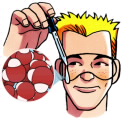Middle School Chemistry is a free complete chemistry course appropriate for students in grades six through eight. You can download it as a single PDF book of 691 pages that includes complete, detailed teaching instructions plus student activity pages. While you can download the entire book, you can also go to “lesson plans” on the website, click on the next lesson, and download one lesson or more at a time. The segmented lessons also allow you to download just the lesson plan, just the student activity pages, or the lesson’s answer key. You can also access the student activity sheets through links embedded in the teacher’s material at points where students will actually use them. Answer keys are available online under the individual lesson plans for each chapter but not within the 691-page book.
Middle School Chemistry would be outstanding as a paid course, but it’s an amazing resource for free! The course is presented in six chapters: Matter—Solids, Liquids, and Gases; Changes of State; Density; The Periodic Table and Bonding; The Water Molecule and Dissolving; and Chemical Change. Each chapter is further broken down into five to ten lessons.
The course employs a “5-E” teaching strategy that walks students through five steps: Engage, Explore, Explain, Extend, and Evaluate. This is a teacher-directed course that requires lesson preparation and presentation.
In the text, each lesson begins with key information for the teacher: key concepts to be taught, a summary of activities and how they relate to the key concepts, the lesson objective, safety reminders, materials required for experiments that students will perform, materials required for teacher demonstrations, and a few practical teaching notes.
The lesson then begins with the Engage portion where the teacher guides students through a discussion and often a demonstration to present the new concept. This is interactive rather than straight lecture. Teacher instructions frequently include web links to pertinent images or videos for students to watch that are generally fairly brief.
The Explore portion of the lesson directs students through an experiment or investigation with step-by-step procedures and detailed activity sheets. Next, the Explain section is the most directly instructional as it covers key concepts. However, even this part of the lesson includes discussion and might include web-linked information. In the Extend section, the teacher challenges students to use critical thinking skills as they apply what they have just learned. Student activity sheets are used through the Explore, Explain, and Extend portions of the lesson and serve as your “fifth E” to evaluate how well students comprehended the lesson.
Lessons include full-color illustrations. The design of the course makes it a great candidate for presentation on a lap top or tablet from which you can teach. You’ll also need immediate online access for the web links from whatever device you use.
Student reading pages might be used as a review or follow up since they are written for entire chapters rather than for each lesson. They include coverage of key concepts in a brief textbook fashion. You might want to print these pages out for a student to keep in a notebook for review.
There are no tests.
Experiments and demonstrations require you to gather resources, but the teacher’s guide tells you exactly where you can purchase unusual items. Sometimes when an unusual item is required for an experiment or demonstration, the author will point you to a video of the demonstration as an alternative—but not always. Among required resources are items such as washers, thermometers, a graduated cylinder, Styrofoam balls, eye droppers, duct tape, a balance, a set of cubes having the same volume but made of different materials, tea lights, isopropyl alcohol, a 9-volt battery, mineral oil, baking soda, salt, cereal, Epsom salt, MSG, sugar, and plastic cups. Chapters 5 and 6 require a number of more specialized items such as calcium chloride, sodium carbonate, and Universal Indicator Solution that you will need to order from a science supply store or other supplier. Again, the author identifies suppliers so you don’t need to hunt for the items. However, acquiring so many specialized resources is often much more practical for a group class than for a single student, so keep this in mind if you choose to use this course… or try to gather a few students for a group class.
While it does take effort and money to acquire specialized science supplies and present this course with its many experiments and investigations, the educational benefit is well worth the trouble. Students should acquire a solid foundation for further chemistry study in high school, and they might have learned to enjoy chemistry (and science in general) because of the engaging and interactive approach of this course.









